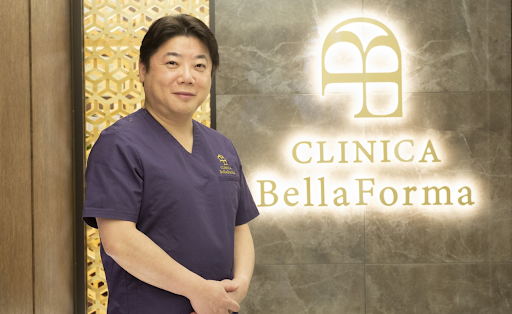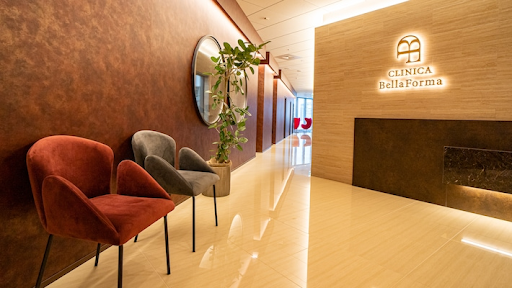CLINICA BellaForma hospital director
Hideaki Sato Dr.

Aging skin and the visible effects of getting older are concerns we all share. Wrinkles, sagging, and other age-related changes are issues many people face. In today’s world of aesthetic medicine, the focus is shifting from simply enhancing appearance to addressing deeper rejuvenation and maintaining long-term health.
Dr. Hideaki Sato, who launched the cosmetic clinic “CLINICA BellaForma,” is at the forefront of this shift. His clinic actively incorporates regenerative medicine, going beyond injections and surgery. After many years of working as a hospital physician, he opened the clinic to provide treatments that align with his vision of ideal medical care.
Dr. Sato focuses not only on the body’s natural regenerative capabilities, but also on oxidative stress. He proposes total beauty care that starts from the inside out, with a focus on inner wellness.
In this interview, we spoke with Dr. Sato about his motivations for opening the clinic, his approach to regenerative medicine, and how he integrates antioxidants into his philosophy.
– What made you decide to open your own clinic?
Dr. Sato: I had worked for many years as a hospital physician, but I wanted to pursue my own medical vision. To truly implement the kind of treatments and concepts I believe in, I felt it was best to start my own clinic.
CLINICA BellaForma offers a full range of aesthetic services—from hyaluronic acid and Botox injections to cosmetic surgery, laser treatments, hair removal, and HIFU. On top of this, we have a strong focus on regenerative medicine.
Regenerative medicine is a next-generation approach that uses “your own cells” to restore what has been lost. While some regenerative treatments are not yet approved overseas, Japan has a legal framework in place. Our clinic has submitted 12 types of regenerative treatment plans and a cell culture facility to the Ministry of Health, Labour and Welfare.
Most clinics outsource their cell cultures, but transporting the cells takes time and may reduce their vitality. That’s why we built an in-house culture facility—so that cells can be harvested and cultured immediately on-site.
We specialize in treatments using dermal fibroblasts, a type of skin cell. We take skin from behind the ear—where there’s less UV exposure—culture it in our facility, and store it until the patient is ready for transplantation. Because younger cells are more robust, it’s possible to extract and store them in your 20s or 30s, then use them later in your 40s or 50s. The goal is to stimulate the skin’s natural rejuvenating power.
– What types of patients visit your clinic?
Dr. Sato: Most patients come in with concerns about wrinkles and sagging. Common treatments include injections, such as hyaluronic acid, as well as surgical procedures and thread lifts. For more fundamental skin improvement, we use regenerative medicine as I mentioned earlier.
Our patients come from a wide range of ages and backgrounds. In fact, we see a high number of international clients, and some patients are even in their teens. Among Japanese patients, the age range spans from the teens to their 90s.
Our international patients, particularly from China, often find us through social media and travel to Japan specifically for treatment. Many of them make direct appointments after seeing information about us online.
– Do you offer a variety of supplements at your clinic?
Dr. Sato: We carry a wide range, including vitamins and NMN. However, I leave most of the supplement selection to my staff—except for one: Twendee Mtcontrol (marketed as Mitocontrol).
I first learned about antioxidant supplements at an anti-aging conference. There, I found out that some have scientific backing in the context of dementia. I have people in my life affected by dementia, and once it sets in, it’s extremely hard to treat. That’s why prevention is key—and supplements may be one of the few realistic options for that right now.
I also read about a study involving opera singers who used antioxidant supplements. They were able to sing more easily—even without practice. Since I give many lectures and speak with patients all day, I rely heavily on my voice as well. That study really stuck with me, and I personally take the supplement now. I also like Twendee S (marketed as Supaliv) and often recommend it to others.
In the past, I’ve offered high-dose vitamin C drips as part of antioxidant therapy. With Twendee Mtcontrol, I mainly recommend it to patients who are focused on cognitive health or overall internal wellness. Many patients who undergo regenerative treatments are highly conscious about beauty and health, so these supplements are a natural fit.
Dr. Sato is not only redefining aesthetic medicine with cutting-edge regenerative techniques, but also focusing on internal wellness through antioxidant strategies. His philosophy centers on helping patients maintain a youthful, healthy state—not just on the surface, but from within. Through his ongoing work, more people will hopefully be able to age gracefully and healthfully with the support of science-backed care.

CLINICA BellaForma
16F Akasaka Stargate Plaza, 2-3-5 Akasaka, Minato-ku, Tokyo 107-0052, Japan
https://clinica-bellaforma.com/